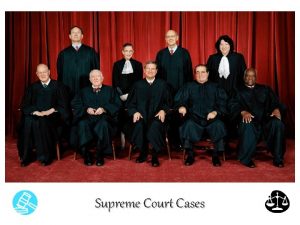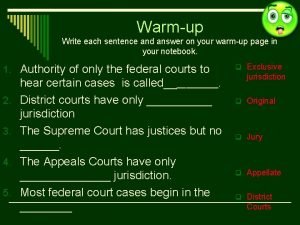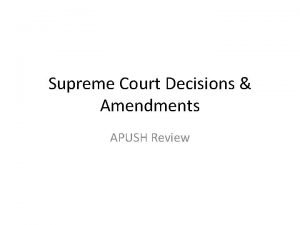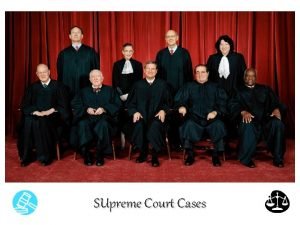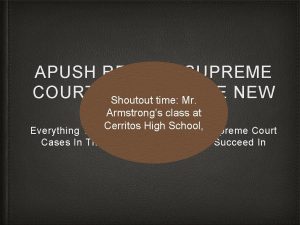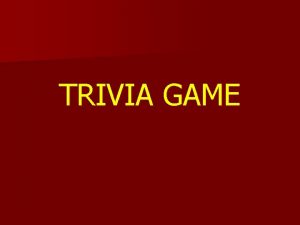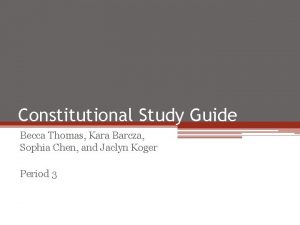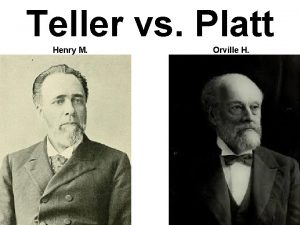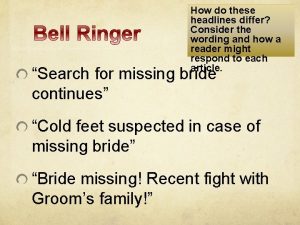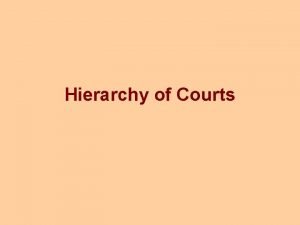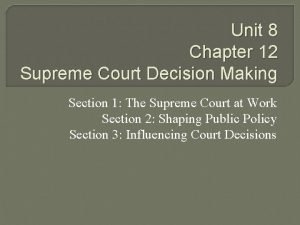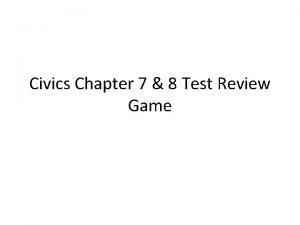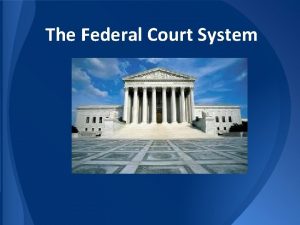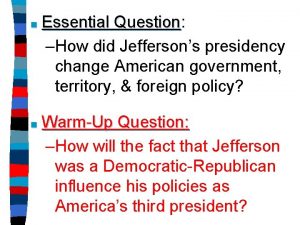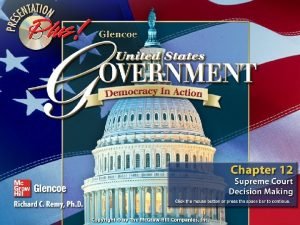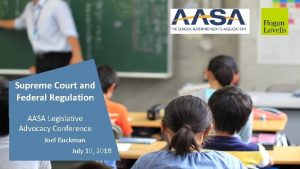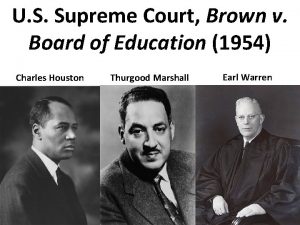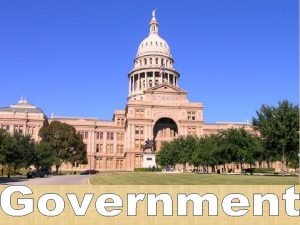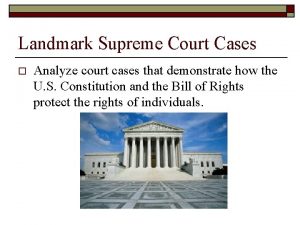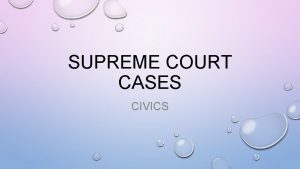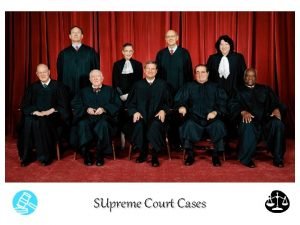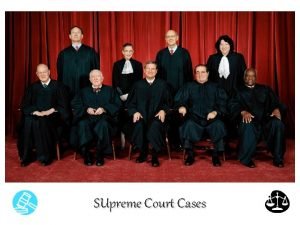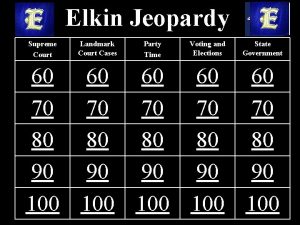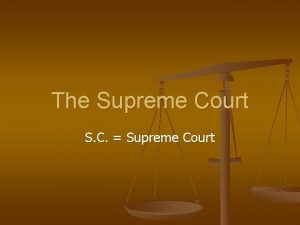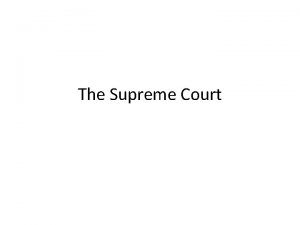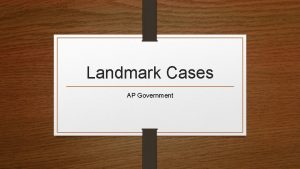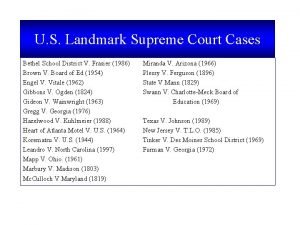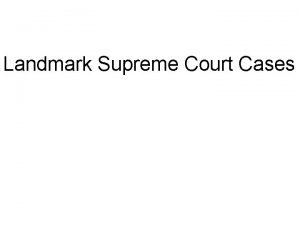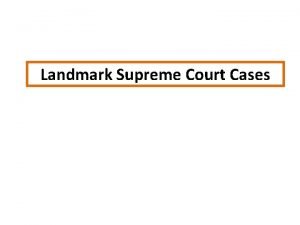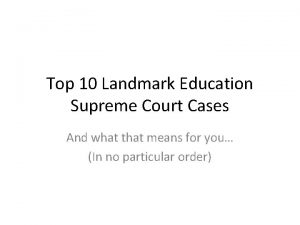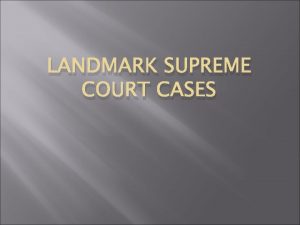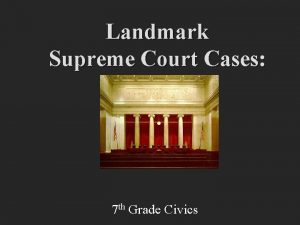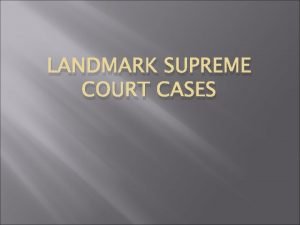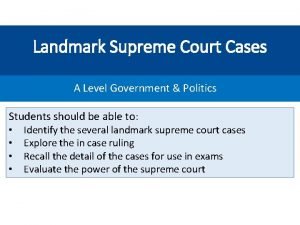LANDMARK SUPREME COURT CASES 14 TH AMENDMENT TH






















- Slides: 22

LANDMARK SUPREME COURT CASES 14 TH AMENDMENT

TH 14 AMENDMENT • The 14 th Amendment to the Constitution was ratified on July 9, 1868. • Granted citizenship to “all persons born or naturalized in the United States, ” which included former slaves recently freed. • Forbids states from denying any person "life, liberty or property, without due process of law" or to "deny to any person within its jurisdiction the equal protection of the laws. ” • By directly mentioning the role of the states, the 14 th Amendment greatly expanded the protection of civil rights to all Americans and is cited in more litigation than any other amendment

CONGRESS – 14 TH AMENDMENT 2 ND SECTION BY KEMBLE, E. W. (EDWARD WINDSOR) 1902 Summary Kemble was a prolific cartoonist and illustrator, best known for his portrayal of African Americans. • Cartoon shows Congress as a fat man asleep in a hammock labeled "Law Enforcement. " • A broken blunderbuss, labeled "14 th Amendment, 2 nd Section, " lies at his feet. • A small black boy walks by holding a drum, but an elephant cautions, "Don't wake him up!" • • The second section of the 14 th Amendment provided for reducing a state's apportionment in Congress if the state prevented any male from voting for any reason other than participation in a rebellion or other crime. There was agitation by various black groups in the early years of the 20 th Century to enforce it, but no serious attempts by the Republican-led Congress were made.

BACKGROUND QUESTIONS PLESSY V. FERGUSON (1896) Use the next 3 slides to answer these questions. 1. What law did Homer Plessy violate? How did Plessy violate this law? 2. What rights do the Thirteenth and Fourteenth Amendments provide? Why did Plessy believe that the Separate Car Act violated these rights 3. Judge Ferguson decided that the state could make laws for railroad companies that traveled within the state but not for those that traveled between states. On what basis can Judge Ferguson treat these two situations differently?

PLESSY V. FERGUSON (1896) “ SEPARATE BUT EQUAL, " - BACKGROUND EQUAL PROTECTION In 1890, Louisiana passed a statute called the Separate Car Act, which stated "that all railway companies carrying passengers in their coaches in this state, shall provide equal but separate accommodations for the white, and colored races, by providing two or more passenger coaches for each passenger train, or by dividing the passenger coaches by a partition so as to secure separate accommodations. . " The penalty for sitting in the wrong compartment was a fine of $25 or 20 days in jail. The Plessy case was carefully orchestrated by both the Citizens' Committee to Test the Constitutionality of the Separate Car Act, a group of blacks who raised $3000 to challenge the Act, and the East Louisiana Railroad Company, which sought to terminate the Act largely for monetary reasons. They chose a 30 -year-old shoemaker named Homer Plessy, a citizen of the United States who was one-eighth black and a resident of the state of Louisiana. On June 7, 1892, Plessy purchased a first-class passage from New Orleans to Covington, Louisiana and sat in the railroad car designated for whites only. The railroad officials, following through on the arrangement, arrested Plessy and charged him with violating the Separate Car Act. Well known advocate for black rights Albion Tourgee, a white lawyer, agreed to argue the case without compensation. In the criminal district court for the parish of Orleans, Plessy argued that the Separate Car Act

PLESSY V. FERGUSON (1896) “SEPARATE BUT EQUAL, " EQUAL PROTECTION BACKGROUND • Thirteenth Amendment - Ends Slavery Section 1. Neither slavery nor involuntary servitude, except as a punishment for crime whereof the party shall have been duly convicted, shall exist within the United States, or any place subject to their jurisdiction. • Fourteenth Amendment Section 1. All persons born or naturalized in the United States and subject to the jurisdiction thereof are citizens of the United States and of the State wherein they reside. No State shall make or enforce any law which shall abridge the privileges or immunities of citizens of the United States; nor shall any State deprive any person of life, liberty, or property, without due process of law; nor deny to any person within its jurisdiction the equal protection of the laws.

PLESSY V. FERGUSON (1896) “ SEPARATE BUT EQUAL, " BACKGROUND EQUAL PROTECTION • John Howard Ferguson was the judge presiding over Plessy's criminal case in the district court. He had previously declared the Separate Car Act "unconstitutional on trains that traveled through several states. " However, in Plessy's case he decided that the state could choose to regulate railroad companies that operated solely within the state of Louisiana. Therefore, Ferguson found Plessy guilty and declared the Separate Car Act constitutional. • Plessy appealed the case to the Louisiana State Supreme Court, which affirmed the decision that the Louisiana law as constitutional. Plessy petitioned for a writ of error from the Supreme Court of the United States. Judge John Howard Ferguson was named in the case brought before the United States Supreme Court (Plessy v. Ferguson) because he had been


Origin of “Jim Crow”

JIM CROW LAWS • “It shall be unlawful for a negro and white person to play together or in company with each other in any game of cards or dice, dominoes or checkers. ” —Birmingham, Alabama, 1930 • “It shall be unlawful for any white prisoner to be handcuffed or otherwise chained or tied to a negro prisoner. ” —Arkansas, 1903 • “No colored barber shall serve as a barber to white women or girls. ” —Atlanta, Georgia, 1926 • “Marriages are void when one party is a white person and the other is possessed of one-eighth or more negro, Japanese, or Chinese blood. ” —Nebraska, 1911 • “Any person. . . presenting for public acceptance or general information, arguments or suggestions in favor of social equality or of intermarriage between whites and negroes, shall be guilty of a misdemeanor and subject to a fine not exceeding five hundred dollars or imprisonment not exceeding six months or both fine and imprisonment in the discretion of the court. ” —Mississippi, 1920 • “Separate free schools shall be established for the education of children of African descent; and it shall be unlawful for any colored child to attend any white school, or any white child to attend a colored school. ” —Missouri, 1929 • “Any white woman who shall suffer or permit herself to be got with child by a negro or mulatto. . . shall be sentenced to the penitentiary for not less than eighteen months. ” —Maryland, 1924 • “All railroads carrying passengers in the state (other than street railroads) shall provide equal but separate accommodations for the white and colored races, by providing two or more passenger cars for each passenger train, or by dividing the cars by a partition, so as to secure separate accommodations. ” —Tennessee, 1891 • “The Corporate Commission is hereby vested with power to require telephone companies in the State of Oklahoma to maintain separate booths for white and colored patrons when there is a demand for such separate booths. ” —Oklahoma, 1915

QUESTIONS – MAJORITY OPINION Use the next 4 slides to answer these questions. 1. What did the Supreme Court determine in a 7 -1 decision? 2. What do the justices state is the object of the Fourteenth Amendment? 3. What did the majority opinion determine about laws and social equality? 4. What did Justice John Marshall Harlan argue in his dissenting opinion? Think about the questions below. Be prepared to discuss as a class. What is the difference between political and social equality? Can one exist without the other?

SUMMARY OF DECISION In a 7 -1 decision, the Supreme Court ruled in favor of Ferguson. The majority rejected Plessy’s Thirteenth and Fourteenth Amendment arguments, instead putting its stamp of approval on the doctrine of “separate but equal. ” The dissent, written by Justice John Marshall Harlan, disagreed, arguing that segregationist laws indoctrinate society with the belief that the two races are not equal.

SUMMARY OF DECISION • Justice Henry Brown wrote the majority opinion, which rejected Plessy’s argument that the Louisiana law conflicted with the Thirteenth Amendment, deeming the point “too clear for argument. ” The justices then considered whether the law conflicted with the Fourteenth Amendment. They identified the purpose of the Fourteenth Amendment as “enforce[ing] the absolute equality of the two races before the law, ” but then asserted that “it could not have been intended to abolish distinctions based upon color, or to enforce social…equality. ” According to the Court, the Fourteenth Amendment was only concerned with legal, not social, equality. • The justices denied the argument that separation of the races by law “stamps the colored race with a badge of inferiority. ” They argued instead that racial prejudice could not be overcome by “an enforced commingling of the two races. ” According to this argument, outlawing segregation would not eliminate racial prejudice, because such societal beliefs could not be changed simply by changing the law. The Court concluded that “if one race be inferior to the other socially, the Constitution … cannot

PLESSY V. FERGUSON (1896) “ SEPARATE BUT EQUAL, " EQUAL PROTECTION "The object of the [Fourteenth] Amendment was undoubtedly to enforce the absolute equality of the two races before the law, but in the nature of things it could not have been intended to abolish distinctions based upon color, or to enforce social, as distinguished from political, equality, or a commingling of the two races upon terms unsatisfactory to either. " —Justice Henry Billings Brown, speaking for the majority

SUMMARY OF DECISION • The justices explained that because the Louisiana law did not conflict with the purpose of the Fourteenth Amendment, the only remaining question was whether it was “reasonable, and … enacted in good faith for the promotion for the public good. ” Giving much deference to the state legislature of Louisiana, they determined that the law met this requirement because it furthered “the preservation of the public peace and good order. ” Thus, so long as separate facilities were actually qualitatively equal, the Constitution did not prohibit segregation in the view of the majority of the Court. • Justice John Marshall Harlan dissented from the majority opinion. In an opinion that later became pivotal in the Brown v. Board of Education cases (1954), he argued that segregationist legislation, like the Louisiana law in this case, was based on the assumption that “colored citizens are so inferior and degraded that they cannot be allowed to sit in public coaches occupied by white citizens. ” These laws promoted and perpetuated the belief that African Americans were inferior to whites, according to Justice Harlan. They must be struck down, he argued, because the government could not “permit the seeds of race hate to be planted under the sanction of law. ” • Justice Harlan believed that the constitution must be “color-blind, ” and that it could allow “no superior, dominant ruling class of citizens. ” Because segregation had the effect of creating such classes,


QUESTIONS – DISSENTING OPINION 1. In what way does Justice Harlan's constitutional interpretation of the Thirteenth and Fourteenth Amendments effectively challenge the majority's interpretation of the same amendments in this case? 2. According to Justice Harlan, what effects will this type of legislation have on the United States and its citizens? 3. What does Justice Harlan believe is the real meaning behind the legislation enacted in Louisiana?

JUSTICE JOHN MARSHALL HARLAN WROTE THE DISSENT. • While there may be in Louisiana persons of different races who are not citizens of the United States, the words in the act 'white and colored races' necessarily include all citizens of the United States of both races residing in that state. So that we have before us a state enactment that compels, under penalties, the separation of the two races in railroad passenger coaches, and makes it a crime for a citizen of either race to enter a coach that has been assigned to citizens of the other race. Thus, the state regulates the use of a public highway by citizens of the United States solely upon the basis of race. • However apparent the injustice of such legislation may be, we have only to consider whether it is consistent with the constitution of the United States. • The thirteenth amendment does not permit the withholding or the deprivation of any right necessarily inhering in freedom. It not only struck down the institution of slavery as previously existing in the United States, but it prevents the imposition of any burdens or disabilities that constitute badges of slavery or servitude. . But, that amendment having been found inadequate to the protection of the rights of those who had been in slavery, it was followed by the fourteenth amendment. . . declaring that 'all persons born or naturalized in the United States, and subject to the jurisdiction thereof, are citizens of the United States and of the state wherein they reside, ' and that 'no state shall make or enforce any law which shall abridge the privileges or immunities of citizens of the United States; nor shall any state deprive any person of life, liberty or property without due process of law, nor deny to any person within its jurisdiction the equal protection of the laws. ' These two amendments [Thirteenth and Fourteenth], if enforced according to their true intent and meaning, will protect all the civil rights that pertain to freedom and citizenship. . .

JUSTICE JOHN MARSHALL HARLAN WROTE THE DISSENT. • The white race deems itself to be the dominant race in this country. And so it is, in prestige, in achievements, in education, in wealth, and in power. So, I doubt not, it will continue to be for all time, if it remains true to its great heritage, and holds fast to the principles of constitutional liberty. But in view of the constitution, in the eye of the law, there is in this country no superior, dominant, ruling class of citizens. There is no caste here. Our constitution is color-blind, and neither knows nor tolerates classes among citizens. In respect of civil rights, all citizens are equal before the law. . . • . . . The present decision, it may well be apprehended, will not only stimulate aggressions, more or less brutal and irritating, upon the admitted rights of colored citizens, but will encourage the belief that it is possible, by means of state enactments, to defeat the beneficient purposes which the people of the United States had in view when they adopted the recent amendments of the constitution, by one of which the blacks of this country were made citizens of the United States and of the states in which they respectively reside, and whose privileges and immunities, as citizens, the states are forbidden to abridge. Sixty millions of whites are in no danger from the presence here of eight millions of blacks. The destinies of the two races, in this country, are indissolubly linked together, and the interests of both require that the common government of all shall not permit the seeds of race hate to be planted under the sanction of law. What can more certainly arouse race hate, what more certainly create and perpetuate a feeling of distrust between these races, than state enactments which, in fact, proceed on the ground that colored citizens are so inferior and degraded that they cannot be allowed to sit in public coaches occupied by white citizens? That, as all will admit, is the real meaning of such legislation as was enacted in Louisiana.

How the Case Moved Through the Court System

IMPACT OF “SEPARATE BUT EQUAL” Think about the following situations. Each situation offers separate accommodations for the people involved. Are those accommodations equal? Do you think the Supreme Court of the United States considered all possible situations when they rendered their decision in Plessy v. Ferguson? Discuss each situation with your classmates. • A black woman is thirsty, so she walks over to the water fountains. There is one fountain for blacks and one for whites. The black woman uses the fountain for whites because the other one is out of order. • A black man has been traveling for many hours. He stops at a diner to eat and use the restroom. This diner only serves whites. In order to eat, the black man must travel another two hours to another diner that serves blacks. The black man cannot wait two hours to use the restroom, so he uses the diner's restroom despite the posted signs. • A white man is not allowed to have his colored attendant with him in the same train coach even though the white man's health condition requires constant supervision. The colored attendant ignores the rules and sits beside his employer in the coach for white passengers. • A black seven-year-old girl must walk two miles to the nearest school for blacks even though there

VIDEO RECAP: • Plessy v Ferguson (1896) by Vision Chasers • Sound Smart: Plessy v. Ferguson (History Channel) RESOURCES: • 14 th Amendment https: //www. loc. gov/rr/program/bib/ourdocs/14 thamendment. html • Plessy v ferguson http: //landmarkcases. org/en/landmark/cases/plessy_v_ferguson#Tab=Overview
 Cohens vs virginia apush
Cohens vs virginia apush How cases reach the supreme court worksheet answers
How cases reach the supreme court worksheet answers Warren court apush
Warren court apush Supreme court cases graphic organizer answers
Supreme court cases graphic organizer answers Important court cases apush
Important court cases apush Is there a basketball court above the supreme court
Is there a basketball court above the supreme court 15th amendment importance
15th amendment importance Platt amendment definition
Platt amendment definition What do these headlines say about how the supreme court
What do these headlines say about how the supreme court Which precedent was established by marbury v. madison
Which precedent was established by marbury v. madison Jurisdiction of supreme court
Jurisdiction of supreme court Indictable offence
Indictable offence Vocabulary activity 12 supreme court decision making
Vocabulary activity 12 supreme court decision making John marshall
John marshall The u.s. supreme court works chiefly as a(n)
The u.s. supreme court works chiefly as a(n) Supreme court
Supreme court Us circuit court map
Us circuit court map John marshall supreme court
John marshall supreme court Supreme court does
Supreme court does Supreme court does
Supreme court does Supreme court
Supreme court Political parties
Political parties Have supreme court
Have supreme court
